You don’t need a quaint old cottage to create a cottage-style garden. Just pack a lot into the borders by blending old-fashioned flowers, useful herbs and vegetables, climbers, self-seeding annuals, and productive fruit trees for an informal, “just happened” natural look. With so much seed, birds will love your yard, and the bees and insects will be in heaven.
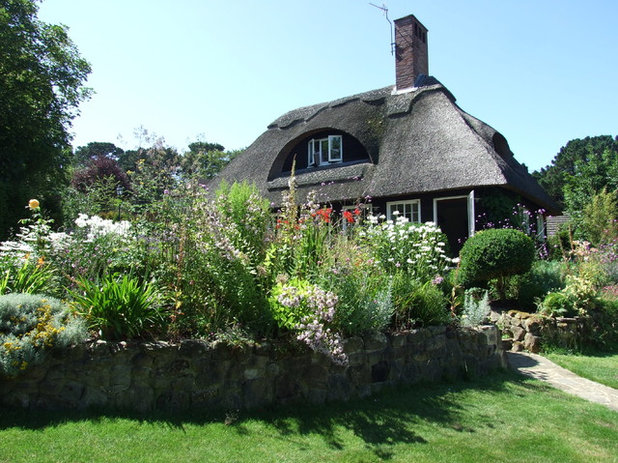
Capability Chris
Get the basics right. There are so many flowering plants to include — forget-me-nots, geraniums, lupines, poppies, primroses, roses, stocks, sweet rocket and sweet william, to name but a few.
Add an old brick path, a discarded farmhouse sink, a bit of topiary, wooden or woven pergolas, an arbor smothered in roses, terra-cotta containers, rustic fencing, vegetable cloches, rhubarb-forcing pots and a beehive, and you’ll have that magical blend for the perfect cottage garden.
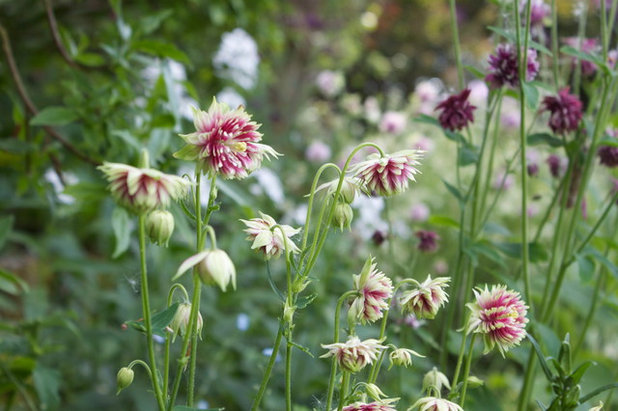
Claudia De Yong Garden Design
Choose your blooms. Aquilegia, commonly known as columbine, produces nodding, spurred flowers with delicate leaves. It self-seeds and comes in many colors: deep blues, pale mauves, pinks, creams and bicolors, as well as double forms, such as the lovely pink ‘Nora Barlow’, above. The deeper, double ‘Black Barlow’ looks stunning teamed with border grasses, such as
Luzula nivea.
Hardy geraniums are a cottage favorite, too, and make good ground covers, especially under roses. Peonies (
Paeonia officinalis) and poppies (
Papaver) are other herbaceous plants associated with cottage gardens. They have blowsy blooms in vibrant colors and soft shades. A favorite of mine is
Papaver orientale ‘Patty’s Plum’.
There are so many cottage-style plants. Here are just a few more: lady’s mantle (
Alchemilla), nasturtiums (
Tropaeolum majus), pansies (
Viola), pinks (
Dianthus),
Salvia, snowdrops (
Galanthus nivalis) and wallflowers (
Cheiranthus cheiri).
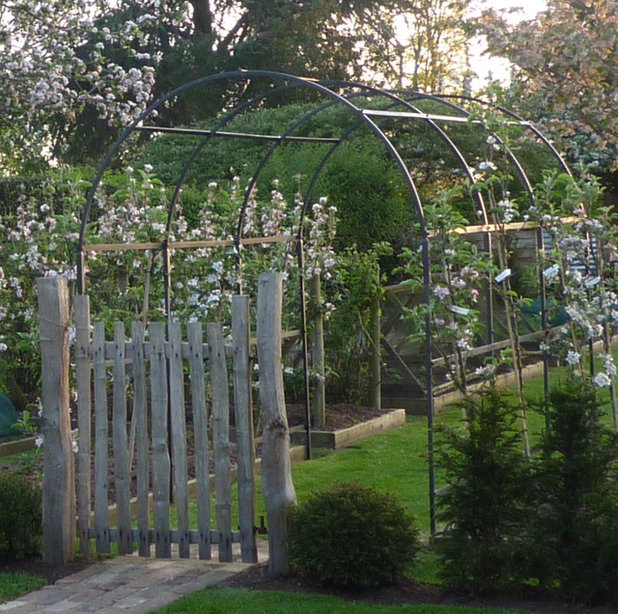
Claudia De Yong Garden Design
Prop up your climbers. To support climbers, you can use arbors, pergolas and arches. Allow plants like beans, clematis, honeysuckle, jasmine, roses, sweet peas and wisteria to scramble up these structures. They’ll add height and create a natural doorway to another part of the garden.
Another plant to consider for an arbor is golden hop (
Humulus lupulus ‘Aureus’). It’s a vigorous climber and needs space to spread. In autumn, when its broad leaves turn golden yellow and it’s covered with dangling cone-shaped flowers that turn to hops, you can cut the long tresses for a lovely addition to indoor decorating.
You can also underplant the bases of supports with self-seeding nasturtium. A cottage favorite, this annual will even scramble over fences and through gates with a mass of trumpet-shaped orange flowers and round leaves throughout the summer.

Claudia De Yong Garden Design
Say hello to a hive. A beehive always looks romantic in a cottage garden. You don’t have to buy a real hive if you don’t intend to keep bees. You can now buy a look-alike hive, which is actually a small storage box or compost bin, or try making one using seasoned wood. You can paint it and secure a roof on top to stop water damage.
Position the hive on a brick path or grassy area where you can allow buttercups and clover to nestle against its legs for a natural look.
Other feature ornaments to include in a cottage-style garden are seats and bowers (shaded, leafy shelters), Victorian forcing pots, cloches and old chimney pots. Traditionally, the cottage garden was often full of discarded or found objects that were reused as decoration among the beds or on paths, or even as a focal point.
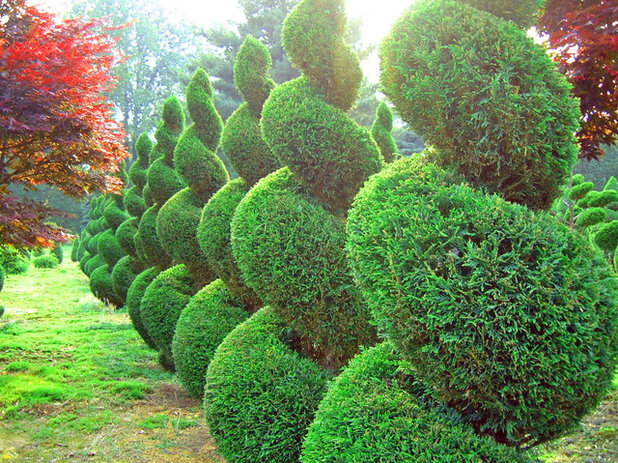
Lee's Oriental Landscape Art
Clip to perfection. Topiary is an important element of the cottage garden, adding structure for the winter months and providing a backdrop for many of the perennial plants. Although holly has traditionally been widely used, other evergreen shrubs can be trained into fashionable cottage garden features.
The classic English yew (
Taxus baccata) and common boxwood (
Buxus sempervirens) can be bought as cone-, ball-, spiral- or pyramid-shaped plants, and if you’re feeling creative with the clippers, you could create your own squirrel or peacock topiary!
Another good plant to clip is
Lonicera nitida, which is slow-growing and has a small leaf. It can also be used as a low hedge between the borders or along a path.
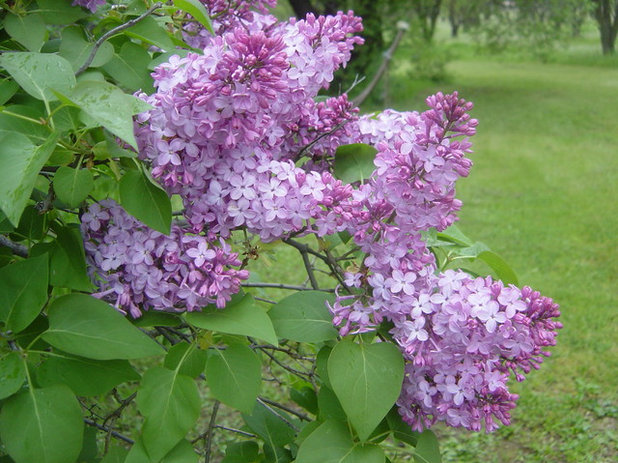
Pamela Bateman Garden Design
Breathe in lilac. Sweet-smelling lilac is short-lived as a flowering tree or shrub, but every cottage garden in its growing range should include one. It’s a shame they’re not often planted anymore.
Mature lilacs, with their twisted and characterful trunks, look good planted next to fruit trees and underplanted with bulbs, foxgloves and sweet rocket. Apart from the well-known
Syringa vulgaris cultivars, you could also consider planting
S. pubescens ssp.
microphylla ‘Superba’, which will flower in the spring and often well into October, though the flowers will be intermittent later in the year. It can also be grown as a hedge or wall shrub.
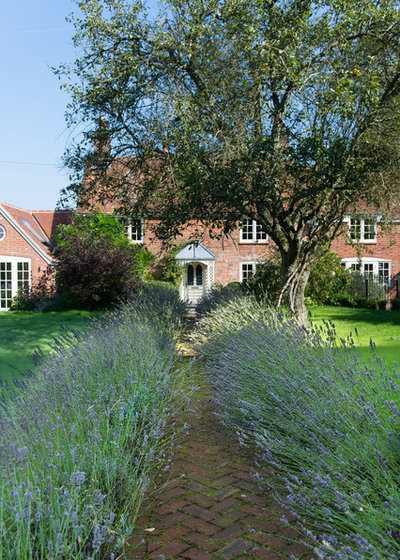
Absolute Architecture
Lay a brick path. A garden with a lavender-edged brick path to the door is what many people picture when they think of traditional cottage style. Brick paths can be laid in straight lines or curved around borders that lead to a vegetable area or around the side of a house.
One method of laying brick paths is to bed the bricks in a sand base. Paths laid using this method are water-permeable, but they don’t always retain their shape over time. And small seeds and plants can naturalize in the cracks. Brick paths also can be bedded in a weak sand and cement mix, which is also used to repoint them. The choice of method can depend on your situation and preference.
If you’re putting down a new brick path in a frost-prone area, make sure that you choose frost-free bricks, so frozen water won’t damage their structure. There are many laying patterns to choose from, such as herringbone, basket-weave or stretcher bond styles.
You can use bricks to edge borders, as the Victorians did. The bricks look good positioned at a 45-degree angle, so their tops make triangle shapes. This will contain straggling plants and neaten edges.
For edging a brick path with lavender, choose ‘Hidcote’ or ‘Munstead’ varieties. Catmint (
Nepeta racemosa ‘Walker’s Low’) also works well along paths, especially if your soil drains poorly, which doesn’t suit lavender.
Landscape Paving 101: How to Use Brick for Your Path or Patio
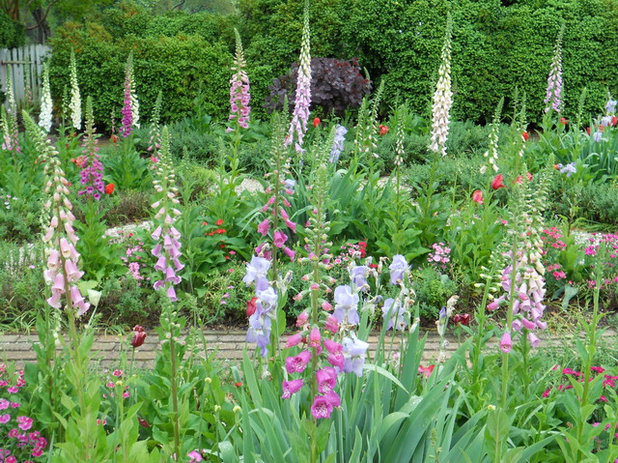
Paintbox Garden
Include tall favorites. Foxglove (
Digitalis purpurea) is a biennial, which would naturally have found its way into the cottage garden from surrounding fields. Once planted in your garden, it’ll soon pop up in unexpected places and thrive in the shade. Foxgloves flower and produce seed in their second year, so you have to plant them two years running to get flowering plants every summer.
No cottage garden should be without another tall favorite, the hollyhock (
Alcea rosea). However, with their huge leaves and large flowers, hollyhocks are susceptible to hollyhock rust, a fungal infection, which can make the plants look untidy. For this reason, these perennials are often planted as biennials — discarding them after they’ve flowered reduces the threat from rust.
Lupines (
Lupinus) and delphiniums (part of the larkspur — Ranunculaceae
— family) are also staples of the cottage garden. Like hollyhocks, they don’t need rich soil or coddling, though delphiniums need feeding and staking.
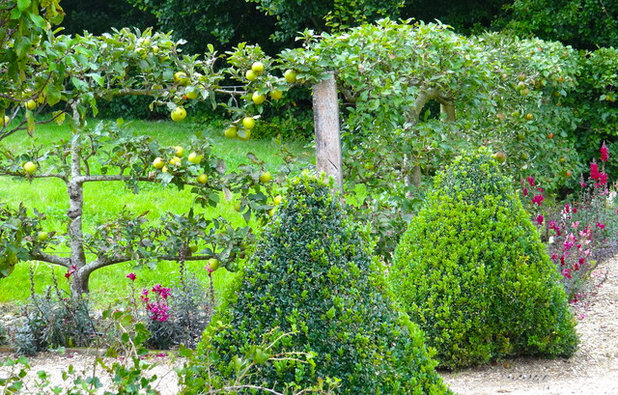
Claudia De Yong Garden Design
Add fruity delights. Productive fruit trees are often found in the flower beds of cottage gardens and can be grown as stepovers or cordons if space is limited.
The most obvious fruit trees are apples, cherries, pears and plums. But if you have the room, try growing a mulberry, which is suited to a large garden, or a medlar (
Mespilus germanica), which has a lovely spreading habit for something a bit different.
Don’t forget to plant a crab apple, such as
Malus ‘Evereste’, which can be trained to grow in a pleached style, adding height and separating areas of the garden.
Pretty Trees for Patios, Paths and Other Tight Spots
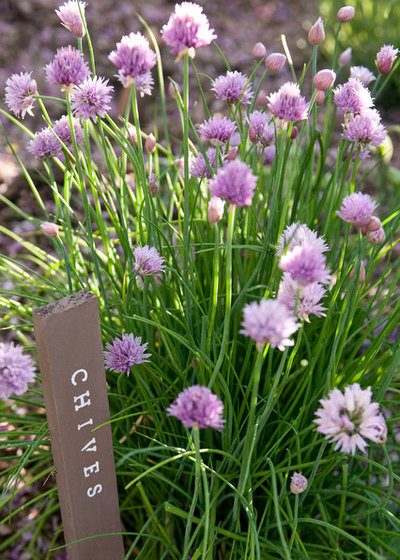
Lucy Call
Do include herbs and vegetables. Traditionally planted amid the flowering herbaceous plants, herbs and vegetables play a big part in a cottage-style garden. Not only do they provide food, but in the case of herbs, they also ward off insects. Herbs are grown for medicinal purposes as well, to make tinctures and treat ailments.
Red vegetables like ‘Bull’s Blood’ beets, ‘Lollo Rosso’ lettuce and Swiss chard give contrast and add interest.
Among the staple herbs, chives (
Allium schoenoprasum) always look good in the garden and self-seed, popping up in the spaces between bricks. They also make a nice edging along paths. Rosemary (
Rosmarinus officinalis) is an old standby too. Thyme (
Thymus) comes in many varieties, from creeping ground covers to large mounding shrubs. Sage (
Salvia officinalis), especially the purple variety, is an aromatic semievergreen shrub that doesn’t disappoint and looks great with catmint (
Nepeta).
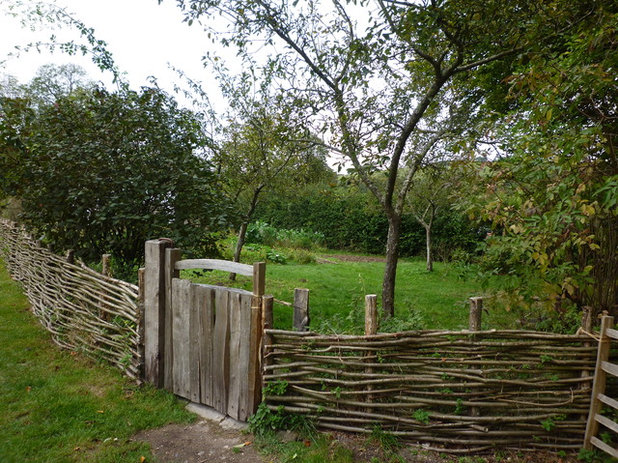
Claudia De Yong Garden Design
Choose the right fence. Rustic-style fencing creates a cottage-style architectural element. Natural woven hazel or willow is the traditional material. You could also use a short picket fence painted in the color of your choice.
Planting a native hedge along the fence will encourage wildlife and year-round interest.
Tell us: Which element of the cottage garden is your favorite? Share your thoughts in the Comments below.





